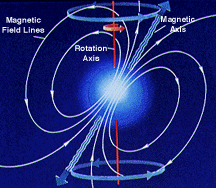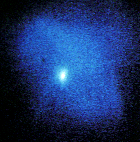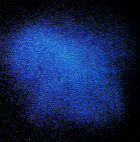Neutron Stars and Pulsars
Neutron stars are about 10 km in diameter and have the
mass
of about 1.4 times that of our Sun. This means that a neutron star is
so
dense
that on Earth, one teaspoonful would weigh a billion tons! Because of
its small size and high density, a neutron star possesses a surface gravitational
field about 300,000 times that of Earth.
Neutron stars are one of the possible ends for a star. They result from
massive stars which have mass in the renge of 4 to 8 times that of our sun.
After these stars have finished burning their nuclear fuel, they undergo
a
supernova
explosion. This explosion blows off the outer layers of a star into a beautiful
supernova remnent. The central region of the star collapses under gravity.
It collapses so much that protons and electrons combine to form neutrons.
Hence the name "neutron star".
Neutron stars may appear in supernova remnants or in
X-ray binaries
with a normal star. When a neutron star is in an X-ray binary, astronomers
are able to measure its mass. From a number of such X-ray binaries, neutron
stars have been found to have masses of about 1.4 times the mass of the sun.
Astronomers can often use this fact to determine whether an unknown object
in an X-ray binary is a neutron star or a black hole, since black holes are
more massive than neutron stars.
What Makes a Pulsar Pulse?
Simply put, pulsars are rotating neutron stars. And pulsars pulse because
they rotate!

A diagram of a pulsar, showing its rotation axis
and its magnetic axis
Pulsars were first discovered in late 1967 by Jocelyn Bell Burnell
as
radio
sources that blink on and off at a constant
frequency
. Now we observe the brightest ones at almost every
wavelength
of
light
. Pulsars are spinning neutron stars that have
jets
of particles moving at the
speed of light
streaming out their two
magnetic poles
. These jets produce very powerful beams of
light
. For a similar reason that "true north" and "magnetic north" are different
on Earth, the magnetic and rotational axes of a pulsar are also misaligned.
Therefore, the beam of light from the jet sweeps around as the pulsar rotates,
and we see pulsars turn on and off as the beam sweeps over the Earth. Neutron
stars for which we see such pulses are called "pulsars".
X-ray Observations of Pulsars
Neutron stars also have very intense
magnetic field
, about 1,000,000,000,000 times stronger than Earth's. Particles are accelerated
to tremendous energies in their "magnetospheres", the name for the region
which is dominated by the neutron star's incredibly strong magnetic field.
Neutron stars may "pulse" due to these electrons accelerated near the magnetic
poles, which are not aligned with the rotation axis of the star. These
electrons
travel outward from the neutron star, until they reach the point, where
their velocity must be faster than the
velocity of light
to still co-rotate with the star. At this radius, the electrons must stop
and release some of their energy in the form of
X-rays
and
gamma-rays
. External viewers see these pulses of radiation whenever the magnetic pole
is visible. The pulses come at the same rate as the rotation of the neutron
star, and, thus, appear periodic.
For pulsars in X-ray binaries, there is another process known as acceretion,
which produces X-rays. In such cases
the companion star in the binary looses some of its material. This material
follows the strong magnetic field lines and falls onto the magnetic poles
of neutron stars. Here neutron star surface gets extremely hot since all
energy of the falling material is converted into heat due to sudden stop
at the surface. This hot surface then emits X-rays, which again are seen
as pulses due to the rotation of the neutron star.
Below, we see the famous Crab
Nebula
, an undisputed example of a neutron star formed during a supernova explosion.
The supernova itself was observed in 1054 A.D. These
images
are from the Einstein X-ray observatory. They show the diffuse emission
of the Crab Nebula surrounding the bright pulsar in both the "on" and "off"
states, i.e. when the magnetic pole is "in" and "out" of the line-of-sight
from Earth.

|

|
|
Crab Pulsar "On"
|
Crab Pulsar "Off"
|
|


